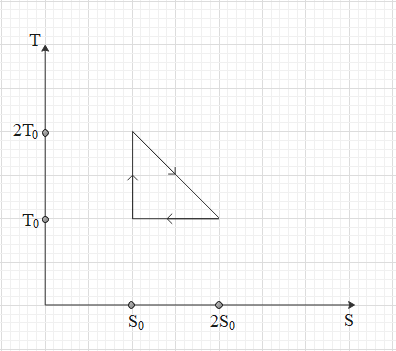
The temperature – entropy graph diagram of a reversible engine cycle is given in the figure. Its efficiency is,

(A) \[\dfrac{1}{4}\]
(B) \[\dfrac{1}{2}\]
(C) \[\dfrac{2}{3}\]
(D) \[\dfrac{1}{3}\]

Answer
576.3k+ views
Hint: The area under the \[T\to S\] gives the change in internal energy of the systems. Efficiency of the engine is given by total work over heat absorbed by the engine. So, in the diagram work done in all three parts equal to the energy given to it or given by it, is the area under that curve with X-axis.
Formula used:
\[\eta =\dfrac{{{Q}_{1}}-{{Q}_{2}}}{{{Q}_{1}}}\]
Complete answer:
The area under the curve in the curve \[T\to S\] gives the heat or can say one of the forms of work.

Here all three processes denoted by different three parts.
For part \[(1)\],
\[{{Q}_{0}}=0\], Because the temperature in this process is constant and therefore no change in its heat.
For part \[(2)\],
The horizontal lines represent the area under this curve. Heat change in second process,
\[{{Q}_{1}}=\dfrac{1}{2}(2{{S}_{0}}-{{S}_{0}})(2{{T}_{0}}-{{T}_{0}})+(2{{S}_{0}}-{{S}_{0}})({{T}_{0}}-0)\]
\[\therefore {{Q}_{1}}=\dfrac{1}{2}({{S}_{0}})({{T}_{0}})+({{S}_{0}})({{T}_{0}})\]
\[\therefore {{Q}_{1}}=\dfrac{3}{2}({{S}_{0}})({{T}_{0}})\]
For part \[(3)\],
The vertical lines represent the area under this curve. Heat change in second process,
\[{{Q}_{2}}=(2{{S}_{0}}-{{S}_{0}})({{T}_{0}}-0)\]
\[\therefore {{Q}_{2}}=({{S}_{0}})({{T}_{0}})\]
Now the efficiency of the engine is given by,
\[\eta =\dfrac{{{Q}_{1}}-{{Q}_{2}}}{{{Q}_{1}}}\]
\[\therefore\eta=\dfrac{\dfrac{3}{2}({{S}_{0}})({{T}_{0}})-({{S}_{0}})({{T}_{0}})}{\dfrac{3}{2}({{S}_{0}})({{T}_{0}})}\]
\[\therefore \eta =\dfrac{1}{3}\]
So, the correct answer is “Option D”.
Additional Information:
Entropy (\[\Delta S\]): Entropy is the measurement of the thermal energy per unit temperature. Generally it is the randomness of the system.
Note:
As in \[P\to V\] area under the curve gives the work done, here also the area under \[T\to S\] gives heat change in the system. It can be understood by the equation \[\Delta Q=T\Delta S\]. Here \[\Delta S\] is a change in entropy. If the temperature is constant in any process then in that process heat change (\[\Delta Q\]) is zero because it is the path independent function.
Formula used:
\[\eta =\dfrac{{{Q}_{1}}-{{Q}_{2}}}{{{Q}_{1}}}\]
Complete answer:
The area under the curve in the curve \[T\to S\] gives the heat or can say one of the forms of work.

Here all three processes denoted by different three parts.
For part \[(1)\],
\[{{Q}_{0}}=0\], Because the temperature in this process is constant and therefore no change in its heat.
For part \[(2)\],
The horizontal lines represent the area under this curve. Heat change in second process,
\[{{Q}_{1}}=\dfrac{1}{2}(2{{S}_{0}}-{{S}_{0}})(2{{T}_{0}}-{{T}_{0}})+(2{{S}_{0}}-{{S}_{0}})({{T}_{0}}-0)\]
\[\therefore {{Q}_{1}}=\dfrac{1}{2}({{S}_{0}})({{T}_{0}})+({{S}_{0}})({{T}_{0}})\]
\[\therefore {{Q}_{1}}=\dfrac{3}{2}({{S}_{0}})({{T}_{0}})\]
For part \[(3)\],
The vertical lines represent the area under this curve. Heat change in second process,
\[{{Q}_{2}}=(2{{S}_{0}}-{{S}_{0}})({{T}_{0}}-0)\]
\[\therefore {{Q}_{2}}=({{S}_{0}})({{T}_{0}})\]
Now the efficiency of the engine is given by,
\[\eta =\dfrac{{{Q}_{1}}-{{Q}_{2}}}{{{Q}_{1}}}\]
\[\therefore\eta=\dfrac{\dfrac{3}{2}({{S}_{0}})({{T}_{0}})-({{S}_{0}})({{T}_{0}})}{\dfrac{3}{2}({{S}_{0}})({{T}_{0}})}\]
\[\therefore \eta =\dfrac{1}{3}\]
So, the correct answer is “Option D”.
Additional Information:
Entropy (\[\Delta S\]): Entropy is the measurement of the thermal energy per unit temperature. Generally it is the randomness of the system.
Note:
As in \[P\to V\] area under the curve gives the work done, here also the area under \[T\to S\] gives heat change in the system. It can be understood by the equation \[\Delta Q=T\Delta S\]. Here \[\Delta S\] is a change in entropy. If the temperature is constant in any process then in that process heat change (\[\Delta Q\]) is zero because it is the path independent function.
Recently Updated Pages
Why are manures considered better than fertilizers class 11 biology CBSE

Find the coordinates of the midpoint of the line segment class 11 maths CBSE

Distinguish between static friction limiting friction class 11 physics CBSE

The Chairman of the constituent Assembly was A Jawaharlal class 11 social science CBSE

The first National Commission on Labour NCL submitted class 11 social science CBSE

Number of all subshell of n + l 7 is A 4 B 5 C 6 D class 11 chemistry CBSE

Trending doubts
What is meant by exothermic and endothermic reactions class 11 chemistry CBSE

10 examples of friction in our daily life

One Metric ton is equal to kg A 10000 B 1000 C 100 class 11 physics CBSE

1 Quintal is equal to a 110 kg b 10 kg c 100kg d 1000 class 11 physics CBSE

Difference Between Prokaryotic Cells and Eukaryotic Cells

What are Quantum numbers Explain the quantum number class 11 chemistry CBSE




